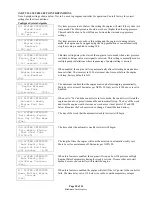
Page 9 of 34
File Name:
Doc#586p.docx
p.
FOAM PUMP OPTION:
An optional feature to operate an external pressure dump valve can be provided for Foam Pump
Service if required. Screen 318 is set to approximately 10-15 seconds to operate a dry contact which can be used to operate
the Dump Valve solenoid. This contact will close when a demand for the pump to run is received such as low pressure,
deluge valve, remote start, weekly test start etc. Once the engine is running, the timing circuit will start and keep the contact
close for the length of time set in screen 318. Then it will open and de-energize the dump valve allowing the pump to
develop full pressure. In addition, if the controller is not activated by a pressure start, the pressure transducer can be
deactivated through screen 319. This will also remove the pressure display from the main status screen of the OID. The
controller can only then be activated by a remote start such as deluge valve or remote start contacts. This a factory settable
option only and must be ordered with the controller before it ships from the factory.
PART V: ADDITIONAL OPTIONAL FEATURES
A.
Battery Charger Operation:
The Battery Chargers are mounted in the engine controller, and are factory wired to the controller
terminal block from which it obtains its 120 volt, 50-60 Hz. supply voltage, and through which it provides charging current to
the batteries. The charging current to the two (2) batteries and the battery voltage is monitored by the controller and displayed
on the OID. The charger output is current limited and provides full protection during the engine cranking cycle. The charger
input and output are fused for protection in case of a failure of the control circuit or other internal component.
Each battery charger is fully automatic, and will charge the batteries at a rate of up to 10 amperes. As the batteries approach full
charge, the current will taper off to a predetermined level at which time the charger automatically switches to the float mode of
operation. In the float mode the charger maintains the batteries at the float potential (approximately 12.7 volts for a 12-volt
battery or 25.4 volts for the 24-volt battery).
The charger provides a means of monitoring the charger output to sound an alarm in case of loss of charger output. This also
provides a means of monitoring the A.C. power since a loss of A.C. power results in a loss of charger output.
Never disconnect the batteries from the controller while the AC power is on to the controller as this may cause damage
to the printed circuit boards.
In the event that a battery is lost or disconnected the output of the charger will stop (0 volts). This will allow the voltage sensing
circuit of the fire pump controller microprocessor to detect a missing battery or open circuit from the battery. This will result in
the respective Battery Fault light to illuminate and the alarm horn to sound. Before reconnecting the battery to the controller,
turn the AC power off. Then reconnect the battery to the controller and turn the AC power back on.to reset the alarm.
Generally, when all conditions are normal, the batteries will come to a full charge prior to the 24 hour period. As batteries begin
to charge, the controller OID will indicate a gradual decrease in current flow. When these ammeters indicate a current level of
less than 0.5 amps the charger will be in a trickle mode.
Check batteries daily for a few days after initial installation has been made, and weekly thereafter. Batteries should be checked
for overcharging (gassing), or undercharging (low voltage, or low specific gravity of the electrolyte or acid.
CAUTION:
Under no circumstances should new electrolyte (acid) be added to a battery that has been previously filled.
Only distilled water is recommended for maintenance purposes.










































